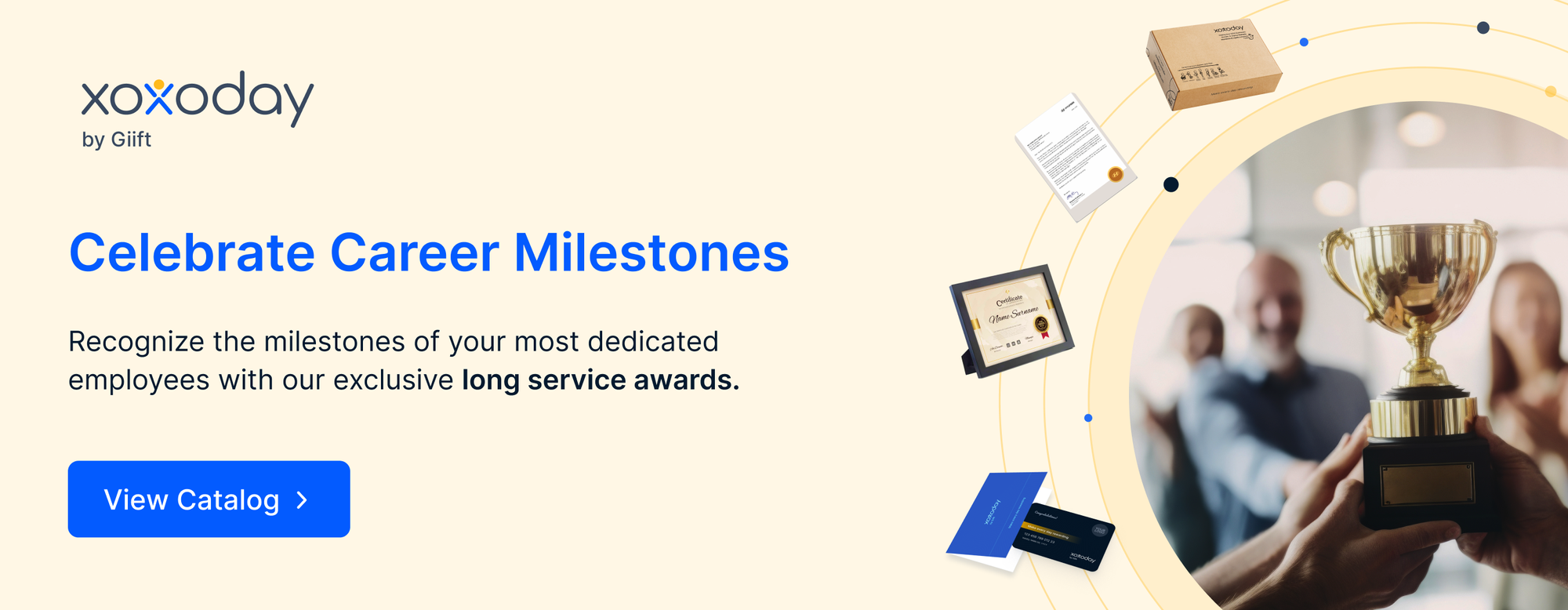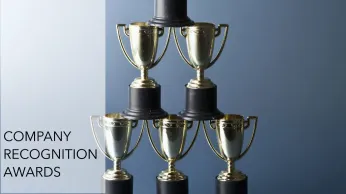Las 29 principales tendencias en programas de recompensas para empleados en 2024
Descubra 29 tendencias en programas de recompensa a los empleados que le ayudarán a inspirarse mientras elabora programas de recompensa y reconocimiento a los empleados para su organización.
En esta página
Para fomentar un ambiente saludable en el lugar de trabajo, una organización debe ir más allá del atractivo de las recompensas económicas. Un estudio de Gallup ha demostrado que los empleados que reciben un gran reconocimiento tienen 20 veces más probabilidades de estar comprometidos que los que no lo reciben o reciben un reconocimiento escaso.
Por lo tanto, no hace falta decir que para apreciar a las personas, los empresarios llevan a cabo y diseñan diversos programas continuos de recompensa y reconocimiento de los empleados.
Estas tendencias en las recompensas a los empleados son un gran gesto para agradecerles su increíble contribución al progreso de la organización.
Entre los tipos de recompensas más comunes para los empleados están las que reconocen:
Premios a la antigüedad: Generalmente en incrementos de cinco años, mediante avisos en el boletín de toda la empresa o cartas personales del jefe de la organización, a veces también con un pin o un certificado. Realice una prueba en 3 sencillos pasos con nuestra encuesta de recompensa por antigüedad

Rendimiento impresionante: Grandes rendimientos a lo largo del tiempo, a menudo para empleados que añaden calidad al proceso de trabajo o al producto, o que proporcionan un servicio superior al cliente o a la clientela.
Una forma de reconocer este rendimiento es animar a los empleados a ofrecer consejos a los nuevos empleados como parte del programa de formación en el trabajo. Esta técnica también puede ayudar a acelerar el crecimiento de la productividad de los nuevos empleados.
Estas recompensas y reconocimientos en las organizaciones pueden ser de naturaleza descendente, descendente o entre iguales. A lo largo del ciclo de vida de los empleados, las organizaciones reconocen sus contribuciones y les motivan con premios al rendimiento (puntuales, mensuales, trimestrales y anuales), premios por antigüedad, premios para celebrar las ocasiones especiales de los empleados, premios de equipo, premios de incorporación, premios por recomendación, premios por bienestar, premios por festivales, premios económicos, etc.
Entre estas prácticas de recompensa y reconocimiento, las recompensas innovadoras, como las experiencias y los vales, pueden permitir a las organizaciones introducirse en la cultura de los empleados y conectar con ellos a un nivel personalizado.
La investigación de Bersin by Deloitte State of Employee Recognition muestra un mercado de 46.000 millones de dólares para el reconocimiento de los empleados, y la mayoría de las empresas gastan en ello entre un 1% y un 2% de la nómina.
Las empresas con los mejores programas de recompensas para empleados también incluyen actividades de aventura, gastronómicas, viajes, pasatiempos, bienestar y actividades que rejuvenecen a los empleados y establecen una comunicación bidireccional, lo que permite a las organizaciones mantenerse estrechamente conectadas con sus empleados.
Las 29 principales tendencias en programas de recompensas para empleados
Descubra 29 tendencias en programas de recompensa a los empleados que le ayudarán a inspirarse mientras elabora programas de recompensa y reconocimiento a los empleados para su organización.
1. Premio a los años de servicio
Este es uno de los tipos de recompensas para los empleados más habituales en las organizaciones, tanto pequeñas como grandes. Este premio se otorga en intervalos o hitos específicos para apreciar y reconocer la contribución continuada de un empleado a una organización durante muchos años.
2. Reconocimiento entre pares
El reconocimiento entre iguales constituye un hermoso gesto de agradecimiento tanto para el que felicita como para el felicitado. Con enfoques de reconocimiento descendentes y descendentes, ofrece una visión de 360 grados de las recompensas y el reconocimiento en las organizaciones.
Aunque el reconocimiento de arriba abajo es una convención en todos los sectores, las palabras de felicitación de los compañeros pueden hacer maravillas para levantar la moral de los empleados. Basta con compartir una nota de felicitación o un elogio verbal con un compañero.
La mayoría de las empresas con los mejores programas de recompensa a los empleados invierten en programas de reconocimiento entre iguales, en los que los compañeros y los directivos están facultados para reconocer y recompensar la contribución de sus colegas.
En Vodafone, existen programas "de igual a igual" o "de jefe a empleado" para reconocer y recompensar el desempeño sobresaliente. Esto incluye recompensas como Vodafone Stars, como SSTars, donde a través de una tarjeta electrónica instantánea de SST, es decir, Velocidad, Simplicidad y Confianza, cualquier empleado puede reconocer a sus compañeros de trabajo en todas las funciones.
Luego están las Superestrellas, premiadas por mostrar constantemente un comportamiento de Velocidad, Simplicidad y Confianza. Cualquier compañero de trabajo o jefe de equipo funcional, o gerente, puede elegir a un empleado cualquier número de veces durante el mes. Las Megaestrellas son premiadas por simbolizar el espíritu de Vodafone y ser un modelo para los demás.
3. Formación o tutoría
Un empresario puede ofrecer al empleado programas de formación que le ayuden a dominar su materia. Hay cursos en los que los empleados pueden inscribirse para mejorar sus conocimientos y obtener una certificación. El empresario puede proporcionar acceso subvencionado o gratuito a sus empleados. Un programa de formación puede impartirse a través de diversas modalidades, como aprendizaje en el aula, vídeos de formación, módulos de aprendizaje electrónico y talleres.
TATA - Harvard Manage Mentor es un programa único de autoaprendizaje realizado por Harvard Manage Mentor en asociación con Harvard Business School Publishing. Ofrece 44 programas diferentes para los empleados de Tata. Este programa incluye: Sala de clase electrónica en vivo, transmisión de video en vivo de auto-aprendizaje.
4. Seminario o talleres
Los seminarios/talleres son una forma estupenda de obtener una información considerable, conocer gente y ampliar las habilidades. Este es uno de los tipos de recompensas para los empleados que ofrece mayores beneficios a la organización, ya que los empleados adquieren valiosas habilidades que pueden aplicarse en el trabajo.
En RMSI se imparten talleres sobre paternidad, psicología infantil, asesoramiento sobre relaciones, etc., para crear un vínculo con los empleados de las familias.
5. Notas de agradecimiento escritas a mano
"Sentirse apreciado es una de las necesidades más importantes que tienen las personas. Cuando compartes con alguien tu aprecio y gratitud, no te olvidará. El aprecio volverá a ti muchas veces".
Steve Brunkhorst - Autor - El simple acto de escribir notas de agradecimiento personalizadas a mano por parte de la alta dirección o del director general de la organización puede hacer que los empleados sean más fieles a la empresa.
El tiempo y el esfuerzo dedicados a escribir notas personalizadas a pesar de la ajetreada agenda garantizan a los empleados que se valora su contribución y se aprecia su duro trabajo.
6. Tarjetas regalo
Detrás del éxito de cualquier empresa están el trabajo duro y la dedicación de sus empleados. Recompensarlos con incentivos no solo aumenta la lealtad, sino que también da un impulso a su rendimiento y garantiza un entorno de trabajo productivo y positivo.
Las tarjetas regalo se utilizan como fuente para motivar las acciones y recompensar los comportamientos de los empleados. Las empresas pueden utilizar las tarjetas regalo de Amazon para premiar y reconocer a sus empleados por sus valiosas contribuciones. Estas recompensas para los empleados les permiten elegir una recompensa para ellos entre una amplia gama de opciones.
7. Ofrecer más flexibilidad y conciliación de la vida laboral y familiar
Una de las cosas que tienen en común las empresas con los mejores programas de recompensa a los empleados es la oferta de horarios flexibles, descansos semanales o trabajo desde casa, que pueden elevar la moral del empleado e incluso su nivel de productividad.
Este tipo de opciones permiten a los empleados mantener un equilibrio entre su vida laboral y personal, especialmente en el mundo actual, donde la competencia es dura y los empleados deben esforzarse más para alcanzar sus objetivos y metas empresariales.
Por ejemplo, empresas como TCS, Wipro, Cognizant, Cisco Oracle, etc., ofrecen horarios de trabajo flexibles a sus empleados. SAP ofrece a sus empleados una política de trabajo desde casa en la que pueden trabajar desde casa una vez a la semana.
KPMG India cuenta con una política de trabajo de suministro, que permite a los empleados "trabajar desde cualquier lugar", ya sea un lugar de trabajo o su casa, siempre que la función pueda ejecutarse virtualmente y que la productividad, el rendimiento y los plazos no se vean obstaculizados, dijo Shalini Pillay, responsable de personas, rendimiento y cultura.
El estudio de Fidelity Investments afirma que el 58% de los millennials considera que la calidad de la vida laboral es más importante que los beneficios financieros. El estudio también dice que los millennials están dispuestos incluso a aceptar un recorte salarial para mejorar la calidad de vida laboral. "En el ajustado mercado laboral actual, un adecuado equilibrio entre la vida laboral y personal es esencial para la retención de los empleados".
Por ejemplo, Nike ofrece a sus empleados beneficios en función de su grado de organización y ubicación. Los beneficios más comunes son los permisos sabáticos pagados, los descuentos en programas de fitness y la ayuda para pagar la matrícula.
8. Plan de opciones sobre acciones para los empleados
Las organizaciones lo han utilizado muy a menudo como estrategia de recompensa. Las empresas hacen uso de esta recompensa para atraer, retener y recompensar el talento y el mejor rendimiento de las empresas.
Los empleados que forman parte de una recompensa de este tipo pueden ganar más riqueza que su compensación actual. Para un empleador, esto sirve para mantener al empleado leal a la organización, ya que está ansioso por alcanzar la riqueza que promete el ESOP.
Ujjivan Financial Services es una empresa que ofrece un plan de opciones sobre acciones para todos los empleados, independientemente de su grado en la organización, ya sea un conductor o el director general. La elegibilidad para esta recompensa se basa exclusivamente en el rendimiento y la permanencia en el puesto. La empresa ha puesto en marcha un portal ESOP para facilitar el acceso a sus empleados y se organizan sesiones periódicas para que los empleados entiendan el concepto.
9. Incentivos de viaje
Los viajes de incentivo son una atractiva recompensa en la que las empresas pueden confiar para animar a los socios o a los empleados a impulsar los objetivos empresariales y aumentar las ventas. Cuando se integra en un programa de recompensas específico, esta recompensa ofrece un estímulo influyente para lograr resultados como motivar e inspirar al personal para mejorar la productividad.
Este programa aporta beneficios como la consecución de un objetivo empresarial, la sensación de atractivo universal, el aumento de la fidelidad y la posibilidad de hacer que la experiencia sea memorable. Mahindra Intertrade Limited: A través del Programa de Incentivos en el Extranjero, los equipos ganadores se desplazan durante cuatro días en un viaje de placer. Eli Lilly & Company (India) Pvt Ltd: Los mejores vendedores realizan un viaje de incentivo internacional de Lilly de una semana de duración junto con su cónyuge, un familiar o un amigo.
10. Premio al contado
A medida que las organizaciones buscan alinear sus estrategias de negocio con sus programas de recompensa y reconocimiento, veremos el crecimiento de los bonos en efectivo al contado en muchas organizaciones para los roles funcionales, destacó un estudio de Hay Group.
Según la Encuesta de Recompensas Totales de 2014 de Mercer, menos de un tercio de las empresas cree que sus recompensas totales y sus estrategias de negocio están totalmente alineadas.
Las recientes tendencias en materia de recompensas totales han establecido que las primas en metálico al contado serán cruciales para establecer el vínculo entre el programa de reconocimiento de los empleados de la empresa y los objetivos empresariales.
La propia naturaleza de la recompensa y el reconocimiento que conlleva permite a los directivos y a los compañeros reconocer el esfuerzo excelente y animarlos al instante. Feather-in-My-Cap de Wipro es un reconocimiento en el acto de un esfuerzo concedido a un proyecto o equipo de proyecto.
11. Almuerzo en equipo
Esta recompensa ofrece a todos los miembros del equipo tiempo para disfrutar de la compañía de los demás en un entorno y un contexto diferentes. Esta recompensa es una gran manera de fomentar la productividad. Ofrece a los directivos la oportunidad de conocer mejor a los miembros de su equipo, pero hay que asegurarse de que no se produzcan discusiones relacionadas con el trabajo durante estos eventos de reunión del equipo.
Se puede llevar al equipo a almorzar a un restaurante, o incluso se puede organizar un plan de convivencia en las instalaciones de la oficina. Este tipo de actividades ayudan a mejorar la unión entre los miembros de un equipo.
12. Clases de yoga / gimnasio / meditación
El yoga, el gimnasio y la meditación ayudan a mantenerse sano y en forma. Ofrecer estos beneficios a los empleados puede ser una gran recompensa. Estos beneficios mantienen a los empleados en forma y concentrados, lo que les permite mejorar su productividad. Google tiene un gimnasio totalmente equipado para sus empleados, mientras que Hindustan Unilever ofrece clases de yoga y una sala de meditación.
13. Premio a las ideas
Esta recompensa es un reconocimiento que la dirección muestra hacia un empleado que ha pensado en una solución o idea única y beneficiosa para la empresa. Por ejemplo: En Wipro, los empleados que aportan una solución o idea creativa y única reciben premios como el Mastermind Award.
14. El acto de bondad o caridad
Muchos de los empleados hacen donaciones benéficas o realizan un acto de bondad. Recompensarles con una pequeña muestra de agradecimiento les subirá la moral y hará que les gusten esos actos de bondad.
Manveeyata Puraskar es un programa de recompensa de NTPC para sus empleados que muestran un acto de humanidad y bondad al azar en su unidad o en los alrededores. Los empleados reciben una carta de agradecimiento y un regalo de hasta 1000 INR/-. Todos los empleados hasta la categoría E7 pueden optar a este premio.
15. Premios de rendimiento
Los empleados merecen un reconocimiento por su contribución específica a la empresa de vez en cuando. Los premios al rendimiento, como los puntuales, mensuales, trimestrales y anuales, constituyen un enfoque estructurado para premiar a los empleados en función de sus méritos y de los resultados empresariales obtenidos.
16. Recompensas para festivales y ocasiones especiales
La celebración de festivales como Diwali y eventos como el Año Nuevo permite establecer una relación de camaradería entre los empleados. Esta bonhomía se puede fomentar a través de conversaciones informales y actividades acordes con la ocasión y de las organizaciones que desean el bienestar de los empleados a través de recompensas por las fiestas.
17. Premios de cumpleaños y aniversarios
Las ocasiones personales de los empleados permiten a las organizaciones comunicar que los valoran como parte de la familia. Cuando las ocasiones de los empleados, como los cumpleaños, las bodas, los aniversarios y la paternidad, se celebran en la oficina, junto con regalos o recompensas, los empleados sienten una grata pausa en su rutina. Se sienten más vinculados a su trabajo y a la organización.
18. Premios del equipo
El trabajo en equipo es indispensable para el éxito de cualquier organización y merece ser reconocido, de forma similar a la contribución individual. Las organizaciones que premian a los equipos de alto rendimiento, en efecto, inspiran a sus empleados para que aprendan a trabajar juntos de forma más estrecha y eficiente.
19. Recompensas que mejoran la experiencia de los empleados
Crear una buena experiencia del empleado ha sido la agenda de los profesionales de RRHH. El estudio Future Workplace and Beyond titulado "The Active Job Seeker Dilemma" dice que el 83% de los líderes de RRHH admiten que la experiencia del empleado es esencial o muy importante para el éxito de su organización.
Una buena experiencia del empleado ofrece muchos beneficios. Estos beneficios van desde la mejora del compromiso de los empleados hasta la mejora del retorno de la inversión. También controla la retención de los empleados y mejora su imagen de marca en el mercado. Los profesionales de RRHH tienen que dedicar tiempo a analizar el mapa de viaje de sus empleados. Esto significa que tienen que invertir en tecnología y en plataformas de compromiso de los empleados.
Esto ayudará a la empresa a controlar la productividad, el rendimiento y el aprendizaje de los empleados. Además, ofrecerá a los profesionales de RRHH una visión de sus empleados. Con esta información, sabrán qué medidas deben tomar para mejorar a sus empleados. Por ejemplo, Google, un gigante de la tecnología, pone mucho empeño en asegurarse de que sus empleados estén contentos.
Las prácticas de experiencia de los empleados en Google incluyen procesos optimizados, tiempo libre pagado para las mujeres embarazadas, proceso de incorporación sincronizado.
20. Unir las delicias
Las organizaciones contratan talentos para aumentar la fuerza de los empleados (requisito básico del negocio) o para contrarrestar el desgaste. Como nota positiva, un comienzo para los nuevos empleados en forma de recompensas de incorporación ejemplifica el adagio: lo bien empezado está medio hecho.
21. Recompensas de bienestar
¿Qué hace que los empleados permanezcan y trabajen con las organizaciones durante mucho tiempo? Su bienestar es uno de los factores. Cuando las organizaciones van más allá de lo convencional para institucionalizar prácticas de bienestar para sus empleados, su capital humano está destinado a aumentar. La Encuesta de Prácticas Críticas de Talento de Mercer de 2014 sugiere que el 49% de las organizaciones se centran en la vida saludable y el bienestar para atraer y retener el talento adecuado.
22. Personalizar las recompensas y el reconocimiento
Ninguna empresa es igual a otra. Entonces, ¿por qué esperar que la estrategia de recompensa y reconocimiento aplicada en una empresa funcione en otra? Una empresa que opta por hacer crecer el talento desde dentro tendrá una filosofía de retribución muy diferente a la de otra que busca contratar a los mejores talentos.
La personalización debe ser el nombre del juego. De lo contrario, se corre el riesgo de alienar a los empleados haciendo descarrilar su productividad. Y eso tiene que ir acompañado de la libertad de elección para que los empleados puedan decidir lo que es mejor para ellos.
23. Vinculación de las recompensas con la PVE
Antes, las recompensas se repartían de forma aislada. Ahora ya no. Las organizaciones son cada vez más conscientes del valor de vincular las recompensas con la propuesta de valor de los empleados. De ahí que las recompensas y el reconocimiento estén hoy estrechamente relacionados con la misión y los valores de la organización, la estrategia empresarial y la cultura organizativa deseada.
Según Willis Towers Watson, la R&R ya no puede operar en un silo unidimensional; considera los beneficios a largo plazo que una PVE puede aportar para impulsar la transformación de la organización.
Aunque las recompensas están cada vez más vinculadas a la gestión del talento y al rendimiento, también incluirán la contribución de un individuo a la cultura de la empresa, el liderazgo del equipo y la estrategia más amplia.
24. Desarrollo de la carrera para tomar un filip
De estas opciones, los programas de desarrollo de la carrera profesional son los que más se van a utilizar en todos los niveles de empleados.
Más de la mitad de los encuestados indican que tienen la intención de ampliar los programas de desarrollo profesional en todos los niveles de los empleados con las habilidades duras y blandas necesarias para asumir roles más desafiantes dentro de las organizaciones. La base de datos global de empleados de Hay Group revela que la falta de oportunidades de desarrollo profesional ha sido citada como la razón número uno por la que los empleados abandonan las organizaciones.
25. Recompensar de forma significativa y con flexibilidad
Hace tiempo, las empresas recompensaban a sus empleados por tener una asistencia impecable. Luego, se pasó a recompensarles por su rendimiento. No se prestaba mucha atención al tipo de recompensas que se daban a los empleados. Hoy en día, las organizaciones se dan cuenta de que es importante recompensar a los empleados y asegurarse de que se les proporciona. Van desde primas en metálico, agradecimientos verbales, pago de horas extras, recompensas en forma de experiencia, beneficios de salud y bienestar, vales, etc.
26. Mayor uso de la tecnología para la comunicación
Con la llegada de la tecnología móvil y los sistemas basados en las redes sociales, las empresas prevén un papel más importante de la tecnología en la administración de los beneficios de recompensa y reconocimiento y su comunicación a los empleados a través de dispositivos web y móviles.
Los expertos esperan una mayor automatización, más transparencia, un portal único para todas las ofertas y una tecnología intuitiva para involucrar a los interesados y proporcionar una atención personalizada a las personas. Antes, la mayoría de los programas de compromiso de los empleados funcionaban en silos dentro de RRHH. Ahora, se pueden tener todos esos programas de compromiso en la misma plataforma tecnológica, lo que permite una integración perfecta.
Estas plataformas como Empuls le proporcionan flexibilidad para definir y diseñar Recompensas y Reconocimiento, simplificar los incentivos de ventas, realizar un seguimiento de los niveles de forma física de los usuarios, proporcionar un módulo de recomendación para la contratación y las nominaciones y aprobaciones.
27. Sistemas de recompensa sensibles
Las empresas deben empezar a utilizar herramientas de reconocimiento de empleados de la nueva era que midan el estado de ánimo diario de los empleados y permitan a los responsables de RRHH tomar medidas correctivas basadas en las encuestas de pulso de los empleados. Es posible que los ERP tradicionales no dispongan de herramientas o funciones integradas para medir los sentimientos de los empleados con frecuencia.
28. Sistemas de recompensa personalizables
Los nuevos productos en el ámbito de las recompensas pueden profundizar; pueden averiguar las preferencias innatas de los empleados ubicados en distintas zonas geográficas y recomendar recompensas relevantes para ellos. Los productos también son más fáciles de personalizar y localizar que los sistemas tradicionales de RRHH.
29. Sistemas de recompensa integrados
El software moderno en el ámbito de las recompensas puede integrarse fácilmente con los sistemas de gestión de recursos humanos y de TI existentes e incluir nuevos escenarios de recompensas. Por ejemplo, se puede combinar una sección de salud y fitness con la gestión de recursos humanos en una aplicación de salud. Los sistemas tradicionales de gestión de recursos humanos y de gestión de la información no son tan fáciles de combinar. Añadir un nuevo módulo puede ser engorroso, y es posible que no se incorporen todos los escenarios de recompensa.
Siguiente nivel de recompensas y reconocimiento
Sus empleados son un activo para su organización. Como afirma Tammy Cohen, "un gran empleado es como un trébol de cuatro hojas, difícil de encontrar y afortunado de tener". De ahí que deba comprobar y seguir las tendencias anteriores. Ofrezca a sus empleados una razón para permanecer conectados y comprometidos con su empresa durante un periodo más prolongado.
Debe asegurarse de que sus empleados disfruten de una gran experiencia y sean recompensados por el trabajo que realizan. No dude en ponerse en contacto con nosotros y compartir su opinión sobre esta entrada del blog. Los programas de recompensa y reconocimiento que ayudan tanto al empleador como al empleado a obtener lo que necesitan del trabajo crean una oportunidad para una situación en la que todos ganan.
Espero que las 29 tendencias anteriores en los programas de recompensas para empleados le ayuden a asumir eficazmente el programa de recompensas dentro de su organización y a ver los resultados positivos.













